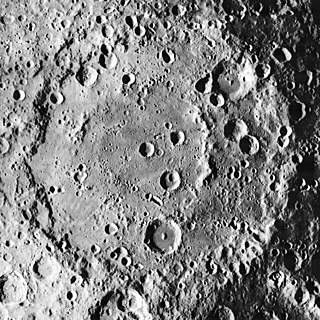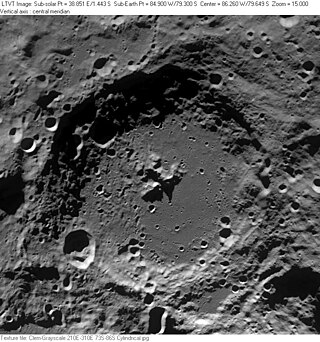
Korolev is a large lunar impact crater of the walled plain or basin type. It is a basin of Nectarian age.

Apollo, also called the Apollo basin, is a large impact crater located on the far side of the Moon, in the southern hemisphere. It was previously known as Basin XVI; in 1970 it was officially named after the Apollo missions by the International Astronomical Union.

Borman is a lunar impact crater that is located in the southern hemisphere on the far side of the Moon. It lies across the southeast section of the mountainous inner ring, within the walled basin named Apollo.

Boss is a lunar impact crater that is located along the northeast rim of the Moon's near side. Due to its location, the crater is viewed from the side by observers on the Earth, and its visibility is subject to libration effects. It was named by the IAU in 1964 for astronomer Lewis Boss.

Drygalski is a large lunar impact crater that lies along the southern limb of the Moon. It partly overlies the crater Ashbrook to the west on the far side of the Moon. Just to the north of Drygalski is the smaller Boltzmann. The location of this crater restricts its observation from the Earth, and even under conditions of favorable libration it is viewed from the edge. It is only illuminated by the Sun at an oblique angle, and it lies close to the south polar craters that are permanently shielded from sunlight.

Hecataeus is a large lunar impact crater that lies near the eastern limb of the Moon. It is attached to the northern rim of the walled plain Humboldt. To the northeast is the smaller crater Gibbs. East of Hecataeus is a chain of small craters forming a line radial to Humboldt; these are designated the Catena Humboldt, named after the walled plain.

Cori is a lunar impact crater that is located in the southern hemisphere on the far side of the Moon. It lies less than one crater diameter to the north of the crater Baldet. To the northeast is the crater Grissom.

Dryden is a lunar impact crater located in the southern hemisphere on the far side of the Moon. It lies within the huge walled plain called Apollo and is one of several features within that basin named after people associated with the Apollo program. Apollo itself has an inner ring, and Dryden is attached to the west-northwest part of that circular mountain formation. To the south of Dryden along the same range is the crater Chaffee.

Oppenheimer is a large lunar impact crater that lies on the Far side of the Moon. It lies along the western outer rampart of the immense walled plain Apollo. Nearby features of note include the dark-floored crater Maksutov to the southwest, and Davisson to the west-southwest. The latter intrudes into the eastern rim of Leibnitz, a feature about 20% larger than Oppenheimer.

Carnot is a large crater in the northern part of the Moon's far side. It was named after Nicolas L. S. Carnot by the IAU in 1970.

Chappell is a lunar impact crater on the far side of the Moon, in the northern hemisphere just to the north of the crater Debye. It is in a heavily bombarded section of the surface, and much of its outer rim is overlain by smaller craters. The northern rim in particular has been almost completely disintegrated, while small craters also overlie the rim to the northwest and southeast. What remains of the rim forms a rounded, somewhat irregular edge to the crater depression.

La Pérouse is a lunar impact crater that is located near the eastern limb of the Moon. It lies northwest of the larger crater Ansgarius, and to the east of Kapteyn. This crater appears foreshortened due to its location, but the rim is nearly circular when viewed from orbit.

Chauvenet is a lunar impact crater that is located to the northeast of the prominent crater Tsiolkovskiy on the far side of the Moon. Less than one crater diameter to the northwest of Chauvenet is the crater Ten Bruggencate.

Ibn Firnas is a lunar impact crater on the far side of the Moon. Attached to the exterior of its southwestern rim is the prominent crater King. Only a few kilometers to the north, separated by a rugged stretch of terrain, is the larger crater Ostwald.

Dobrovolʹskiy is a small lunar impact crater on the Moon's far side. The northwest part of its rim is intruded upon by the somewhat larger crater Shirakatsi, and the outer rampart of that feature covers most of the interior floor of Dobrovolʹskiy. Very little of the original floor now survives, with a small section near the southern inner wall. The remainder of the crater rim is somewhat circular and only mildly worn.

Grissom is a lunar impact crater that lies on the far side of the Moon. It is located just to the south of the huge walled plain Apollo, and to the northeast of the crater Cori. The rim of Grissom is eroded in places, particularly along the northeast where a pair of small craters lie along the sides. There is a clustering of small craterlets located to the south of the crater midpoint. A small crater lies along the northeast edge of the floor.

Icarus is a lunar impact crater that lies on the Moon's far side. It is located to the west of the huge walled plain Korolev, and less than two crater diameters to the east of the crater Daedalus. To the south of Icarus is the smaller Amici.

Onizuka is a small lunar impact crater that lies within the inner ring of the walled plain Apollo. The central portion of Apollo has been covered by dark basaltic lava, and Onizuka lies at the southern edge of this plain. To the southeast of Onizuka is the crater Borman, and to the west-southwest is Chaffee.

White is a lunar impact crater. It lies on the far side of the Moon from the Earth, to the southwest of the huge walled plain Apollo. About one crater diameter to the south-southwest is the small crater Hendrix.

Smith is a lunar impact crater that is located within the huge walled plain Apollo, on the far side of the Moon. This crater is attached to the west-southwestern outer rim of Scobee and it overlies the northern edge of the inner mountain ring within Apollo. To the north lies Barringer.





















